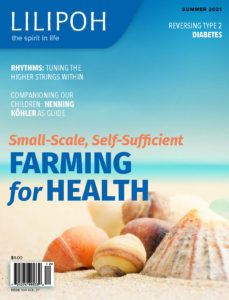Rhythms: Tuning the Higher Strings Within Us
Our bodies long for rhythm.
All life processes in man and nature love rhythms and sequences of time. However, we do not come into life with all our rhythms regulated. The rhythms in the infant and child are still undeveloped and need the parents’ support and guidance. Because we are free to control and influence many of these rhythms, we may fall into the error of disregarding their importance. However, lack of attentiveness to rhythms for long periods can cause physical collapse resulting in illness.
One of the major problems in this time of hectic lifestyles is finding a balance in our rhythms. Our bodies long for rhythm. All our organs have their own rhythms, which need a schedule for sleeping, bathing, working, and rest. We have what is referred to as an internal clock, or circadian rhythm, which regulates all our body’s functions over a cycle of twenty-four hours. It is known in Chinese medicine and anthroposophical medicine all our organs have a rhythm and times of the day when they function optimally. For instance, the liver has a regenerative time from three o’clock in the afternoon to three o’clock in the morning. In light of this rhythm it is best to eat our heavy meals, proteins, oils et cetera at breakfast and lunch, to eat light at supper, and never to eat late at night.
Enough sleep is one of the most important prerequisites for good health. Sleep patterns should follow the rhythms of the sun. Ideally we should get up early with the sun, no later than eight o’clock in the morning, and go to bed not too long after the sun sets for children and no later than eleven o’clock at night for adults. Problems with rhythms arise when the internal rhythms become out of sync with the surrounding environment. This can occur, for example, with shift work, long work days, heavy work loads, high stress, or travel. It often takes several days to fully adjust our circadian rhythms to a new schedule. Going back and forth between schedules over a period of time can result in illness. Sleep rhythms, which renew us physically and spiritually, need to follow a regular time schedule uninterrupted as much as possible.
Regular rhythms foster good habits.
Rhythms give us strength. Any rhythmically repeated action takes less exertion and energy than a one-time action performed at an unusual time or under unusual circumstances. Our rhythms and habits develop our character and personality and also strengthen our will. Learning to observe regular times for eating and sleeping, and structuring our day so it allows for a breathing process, helps us meet the demands of life in a more productive way. As in nature, we need healthy rhythms to be healthy.
We find our connection to nature and the cosmos through rhythms.
Rhythms connect us to nature and the cosmos. The rhythms which regulate the course of the planets against the fixed stars are also reflected in the life processes of the plants, animals, and human beings. Living into the seasons, the sequence of day and night and the life cycles of our biography bring healthy maturation. In this way we can connect with all of creation.
Waldorf education is founded on healthy rhythms.
A model out of which one can connect to the importance of rhythms for children is Waldorf education. The very foundation of Waldorf education is based in rhythms. There are patterns of activity during the day. For example, the morning verse and circle time are anchors in the day which children can count on and orient themselves to. There are repetitive words in the verses and songs that are a part of the activities and games. The daily, weekly, and seasonal rhythms of nature are brought to the children through activities such as baking, gardening, nature walks, and creative play. These many rhythms help develop a sense of security in children and help them to move through the world with confidence, especially if also followed at home.
Rhythms can be daily, weekly, monthly, and yearly.
There are many ways we can cultivate rhythms in our lives and the lives of our children. We could start with daily rhythms, that could include all life’s necessary actions such as bathing, eating, playing, and sleeping which should all be at regular times. Also each day of the week could have a special meaning. For example, there might be certain chores and tasks for some days while Sunday might be more of a festive day in a family home.
In monthly rhythms, each month has its unique name. One could have a special calendar for the months, or observe seasonal changes. The monthly rhythm can be one of recuperation, habit development, and stabilization. Because it takes at least four weeks for a new habit to form, Waldorf education divides instruction into four-week subject blocks wherever possible.
Yearly rhythms bring the possibility of adaptation. Anything we have experienced or done for a year truly lives and stays with us. Additionally, through a year we can follow the seasons and their meaning in our inner lives such as historical events, birthdays, and yearly seasonal holidays. These times also strengthen our relationships to family, community, and nature. Gardening is, of course, an ideal way to use daily, monthly, and yearly rhythms to know more deeply, every year, the natural world.
“Nature is an aeolian harp, a musical instrument whose tones are the re-echo of higher strings within us.” Novalis
This article is from Essentials of Homecare by Jeanne Schirm, RN, Anthroposophic Nurse Specialist and member of the North American Anthroposophic Nurses Association.
The North American Anthroposophic Nurses Association welcomes your interest in further training in caregiving and nursing anthronursing@gmail.com

